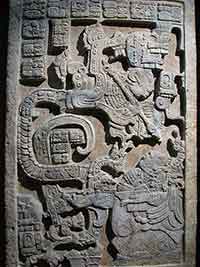Land of the Maya
Yaxchilan


Yaxchilan is located on the south bank of the Usumacinta River, at the apex of a horseshoe-shaped meander. This loop defends the site on all sides except for a narrow land approach from the south. The site lies in Ocosingo Municipality of the state of Chiapas, on the Mexican side of the international border with Guatemala.
The site contains impressive ruins, with palaces and temples bordering a large plaza upon a terrace above the Usumacinta River. Yaxchilan is known for the large quantity of excellent sculpture at the site, such as the monolithic carved stelae and the narrative stone reliefs carved on lintels spanning the temple doorways Over 120 inscriptions have been identified on the various monuments from the site.

The site is set within a beautiful jungle-type environment which is the home for many colorful birds and exotic plants. This dramatic contrast between the town and the jungle, which are in such close proximity, makes Yaxchilan a unique place to visit. In only a few minutes walk a person leaves the hustle and bustle of present-day San Ignacio and enters an atmosphere where life remains in its natural state and ancient monuments become silent testimony of a vigorous civilization that once was. Access to the site is primaraly by way of motorized canoes. Most of the hotels in Palenque can arrange a tour for you.
The major groups are the Central Acropolis, the West Acropolis and the South Acropolis. The South Acropolis occupies the highest part of the site. The site is aligned with relation to the Usumacinta River, at times causing unconventional orientation of the major structures, such as the two ballcourts.
Lintel 24 depicts a sacred blood-letting ritual which took place on 26 October 709. King Itzamnaaj B'alam II is shown holding a torch, while his wife Lady K'ab'al Xook draws a barbed rope through her pierced tongue.

Lentel 25 depicts Lady K’ab’al Xook, wife of Shield Jaguar. Lady Xook performs a bloodletting ritual that has manifested a vision of a serpent. From the mouth of the serpent, a warrior, carrying a shield and spear, emerges. Scholars have debated the identity of this figure. Some argue that it represents Shield Jaguar, others that it is Lady K’abal Xook herself in another form.
